กิจกรรมการประเมินความเสี่ยงของคนไทยต่อสารซัลไฟต์
13 ตุลาคม 2547

บทสรุปสําหรับผู้บริหาร
โครงการการประเมินความเสี่ยงของคนไทยต่อสารซัลไฟต์
การวิเคราะห์ความเสี่ยง ( Risk analysis ) เป็นแนวทางในการพัฒนาและปรับปรุงด้านสุขลักษณะอาหารที่สําคัญในปัจจุบัน ซึ่งกิจกรรมที่ต้องดําเนินการในการวิเคราะห์ความเสี่ยงคือ
การประเมินความเสี่ยง ( Risk assessment ) ของอันตรายที่สําคัญต่อสุขลักษณะของอาหาร และความปลอดภัยของผู้บริโภคคนไทย โดยที่การประเมินความเสี่ยงจะดําเนินการตามขั้นตอนที่เสนอโดย Codex ซึ่งประกอบด้วย 4 ขั้นตอน หลักคือ
1. การบ่งชี้ถึงอันตราย ( Hazard identification )
2. การอธิบายลักษณะอันตราย ( Hazard characterization )
3. การประเมินการได้รับสัมผัส ( Exposure assessment )
4. การอธิบายลักษณะความเสี่ยง ( Risk characterization )
เพื่อให้เป็นไปตามแผนงานโครงการพัฒนา และปรับปรุงด้านสุขลักษณะอาหารแห่งชาติ จึงได้มีการจัดตั้งกลุ่มคณะทํางานเกี่ยวกับการประเมินความเสี่ยงของอันตรายไม่ว่าจะทางจุลินทรีย์ เคมีหรือชีวภาพ และการศึกษาในครั้งนี้จะเป็นการประเมินความเสี่ยงของอันตรายด้านเคมีในเรื่องการประเมินความเสี่ยงของคนไทยต่อสารซัลไฟต์ ( Risk posed on Thais Exposed to sulfite in foods ) เพื่อให้บรรลุวัตถุประสงค์หลักคือ
1. เพื่อประเมินข้อมูล และสถานการณ์ต่างๆ ที่มีในประเทศไทยที่จะใช้สําหรับการประเมินความเสี่ยงต่อสารซัลไฟต์
2. เพื่อให้ทราบถึงรูปแบบการใช์สารซัลไฟตืในขบวนการเตรียมและการแปรรูปอาหารในประเทศไทย
3. เพื่อประเมินการบริโภคอาหารที่มีความเสี่ยงต่อการได้รับสารซัลไฟต์
4. เพื่อคาดคะเนการได้รับสารซัลไฟต์ของประชากรไทยจากการบริโภคอาหาร
5. เพื่อพัฒนารูปแบบตัวอย่างทางเลขาคณิต ( Mathematical model ) ที่จะช่วยในการคาดคะเนระดับความเสี่ยงต่อการได้รับสารซัลไฟต์ผลการศึกษาในครั้งนี้คาดว่าจะทําให้ได้รูปแบบตัวอย่าง ( Model ) ที่สามารถทํานายความเสี่ยงมีผลต่อค่าการบริโภคต่อวันของซัลไฟต์สําหรับช่วงเวลาหนึ่ง ได้ข้อมูลค่าความเสี่ยงของวัตถุเจือปนอาหารซัลไฟต์สําหรับคนไทยเพื่อใช้กําหนดมาตรฐานอาหารของประเทศ และใช้ต่อรองข้อกําหนดมาตรฐานอาหารสากล และตางประเทศที่เป็นคู่ค้าของไทยซึ่งการดําเนินการวิจัยจะมีงบประมาณในการดําเนินการประมาณ 993,000 บาท โดยได้แจกแจงรายละเอียดไว้ในส่วนของงบประมาณ
ทางคณะผู้วิจัยเล็งเห็นว่าข้อมูลต่างๆ รวมทั้งรูปแบบในการประเมินความเสี่ยงจากสารซัลไฟต์จะทําให้ประเทศไทยได้รับประโยชน์อย่างมากในการพัฒนาและปรับปรุงสุขลักษณะของ
อาหารได้อย่างครบวงจร
SULFITE RISK ASSESSMENT PROJECT
National Food Institute
Jocelyn O. Naewbanij
Orawan Kaewprakaisangkul
Chularat Kiratisehwe
Ornanong Mahakkapong
Narumon Kongton
Institute of Nutrition, Mahidol University
Wenika Benjapong
Nednapis Tananivetkul
Piyanuch Visetchart
ABSTRACT
To enhance capacity building in the area of risk assessment, the National Bureau of Agricultural Commodities and Food Standards has funded risk assessment projects that would provide researchers a hands-on training while simultaneously working on related project research themselves.
Sulfites are food additives commonly used for their anti-oxidant and preservative properties. Their long history of safe use obtained them a Generally Recognized as Safe (GRAS) status. Their numerous applications and wide availability in the markets have made them a popular food additive choice for the food retailers at large while the limited knowledge of its use and properties have consequently resulted in its abusive use posing health risk threat to consumers.
Codex Committee on Food Additives and Contaminants on its on-going food safety review of food additives has recommended an acceptable daily intake (ADI) of 0.7mg SO2/kg BW/day for sulfites while the Thai FDA has set different maximum sulfite levels for different products, based on Thailand’s normal product consumption, product type and the mode by which the product is consumed.
Despite the existence of regulations to control the use of sulfites in foods, the absence of standard sulfiting procedures for the different food products appears to contribute to the seemingly abusive use of sulfite additives in Thailand. This study therefore is aimed at assessing the level of exposure of the population under study to sulfites and to assess their potential health risk exposure.
Adverse health impacts of sulfites have been reported to range from stomach irritation to destruction of thiamine and other B-vitamins, which are important in the maintenance of growth. Sulfites are also known to cause idiosyncratic reactions among sulfite-sensitive individuals, particularly asthmatics but their reactions to sulfite are not related to threshold toxicity and therefore is not addressed by the present risk assessment study. Idiosyncratic reactions to sulfites vary from individual to individual, with some being extremely sensitive that complete absence of sulfite is required. Because sulfite does not pose harm to the majority of the consumers but maybe extremely fatal to sulfitehyper-sensitive individuals, Codex and most national governments impose that sulfite-containing products be labeled.
Data collected from 2,701 sulfite-analyzed samples from six service food laboratories indicated that a wide range of products contains sulfites. Crude estimates of the Thai’s exposure to sulfites were estimated by multiplying the average sulfite content (as SO2) of the food product by the food consumption data.
Given the time and financial constraints, an on-the-job training exercise in risk assessment was conducted in Bangkok and Nakorn Pathom to obtain a snap shot picture of their sulfite intake. Using a food frequency consumption survey, consumption data of the 395 respondents from the three municipalities of each of the two provinces were collected. The number was calculated using a statistical equation that provides a 95%confidence level and a 10% error margin. To ensure that gender and age are equally represented in the food consumption survey, a structured random survey sampling was used. Similarly, food samples for sulfite analysis were also randomly collected from the respective areas surveyed.
Mean sulfite intake of the population surveyed was estimated at an average of 0.20 mg SO2/kg BW/day, which is only 28% of the Codex ADI. This can be interpreted that on the average, our exposure to sulfite does not pose health risk. However, estimating the 95 Percentile sulfite consumption yielded an average intake of 0.98 mg SO2/kg BW/day, which is 141% of the Codex ADI. The ratio suggests that there is a sector in the population that is running a health risk from high sulfite consumption.
Results further indicate that the mean risk to sulfite exposure of the male respondents whose exposure averaged at 0.32 mg SO2/kgBW/day which is 45% of the Codex ADI, was higher than the female, whose exposure averaged at 0.17 mg SO2/kgBW/day or 24% of the Codex ADI.
Alcoholic beverage accounted for 0.11 mg SO2/kg BW/day consumption of the men which is 16% of the Codex ADI or 36% of their daily sulfite consumption. In women, fruits accounted for 0.08 mg SO2/kg BW/day of their sulfite consumption, which constitutes 11% of the Codex ADI or 46% of their entire daily sulfite consumption.
Three major shortcomings that could have contributed to uncertainties in this study were identified as follows:
(1) consumption data - consumption data used in risk exposure assessment and risk characterization were derived from the data collected by the present study (2004) and that collected by the Ministry of Public Health in 1995, which is rather old and perhaps no longer reflect the present consumption;
(2) SO2 method of analysis - method used by the Department of Medical Science Laboratory was modified Rankine method while the rest of the laboratories used Modified Monier-Williams and Optimized Monier-Williams method.
(3) collected laboratory data - data obtained and reviewed from different laboratories were from products collected/sampled for different purpose, which can pose discrepancies in results.
In designing future risk assessment study, we need not only an updated food consumption data but also an activity plan designed to address the above shortcomings. To obtain a more realistic and accurate chemical exposure assessment, we also need to study and estimate cooking and processing factors for inclusion in risk estimation.
Keywords: Sulfite risk assessment, Thailand sulfite consumption, Thai sulfite exposure, sulfite exposure assessment



